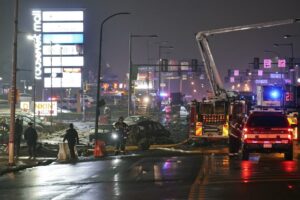How the deadly NE Philly plane crash impacted air, water and soil
February 7, 2025
This story is part of the WHYY News Climate Desk, bringing you news and solutions for our changing region.
From the Poconos to the Jersey Shore to the mouth of the Delaware Bay, what do you want to know about climate change? What would you like us to cover? Get in touch.
The plane crash in a Northeast Philadelphia neighborhood that killed seven people, injured two dozen others, created a mushroom-cloud explosion and left a crater at least 8 feet deep will likely require further environmental remediation. It sparked a three-alarm fire that raged for about two hours, torching cars, burning at least five homes and briefly spreading into the sewer system.
Here’s what to know about the health and environmental impacts.
Air quality impacts during the fire, but no long-term effects
Several days after the crash, James Garrow, a spokesperson for the city’s Department of Public Health, said at “no point” during the incident did any air pollutants or air toxics “reach a dangerous level.”
But “anytime there’s a fire and visible smoke, then there is a localized air quality issue,” said Peter DeCarlo, a professor who studies air quality at Johns Hopkins. “The question is how much does that dissipate … by the time it gets to where people live.”
Fires that burn fossil fuels, including jet fuel, produce several cancer-causing substances, including benzene and a class of compounds found in cigarette smoke known as polycyclic aromatic hydrocarbons, said Arthur Frank, a professor emeritus of environmental and occupational health at Drexel University and member of Philly’s Air Pollution Control Board.
But the worst pollutants from Friday’s fire likely came not from the jet fuel itself, but from the structures that burned, said Marilyn Howarth, an adjunct professor of pharmacology at the University of Pennsylvania and director of the Community Outreach and Engagement Core at the school’s Center of Excellence in Environmental Toxicology.
Unhealthy compounds in plastics and other building materials can burn more slowly and at lower temperatures than those in jet fuel, creating a greater risk of exposure, Howarth said. House and tire fires also produce small particles that can get deep into the lungs. These hazards can exacerbate issues such as asthma and chronic obstructive pulmonary disease (COPD), and in extreme cases, cause heart attacks.
“The jet fuel … that’ll burn reasonably clean,” Frank said. “It’s the other fires — the parts of the airplane and the house fires that occur, the car fires, the tires — those will put out a lot of particulate matter.”
Residents near any burning structure should leave the area or shelter in place and turn off any type of ventilation system until the smoke has cleared, Howarth said. How dangerous smoke is depends on how close a person is to the source and how long they’re exposed. Wind speed and direction play a big role in how quickly air pollution disperses.
Philadelphia’s Air Management Services monitored the air pollution created by Friday’s plane crash in several ways.
Shortly after the fire was reported under control, a mobile van started monitoring pollutants a few blocks away from the site of the crash, according to data provided by AMS. The van measured levels of several unhealthy, toxic or cancer-causing pollutants, including particulate matter, benzene and formaldehyde.
Then, around 9 p.m., officials took a sample of the air quality a few blocks away from the site of the crash for testing. This snapshot found levels of toxic compounds orders of magnitude below workplace standards set by OSHA. The federal agency has acknowledged, however, that many of these standards are “outdated and inadequate for ensuring protection of worker health.”
Still, the levels of pollutants AMS measured “were really quite low,” Frank said.
“I didn’t see anything that really concerned me,” he added.
While the levels of toxins measured were generally low, the sample likely did not capture the worst of the pollution, because it was collected after the flames were doused, Howarth said.
“The canister sampling that they did is a very brief grab of air,” Howarth said. “It is a good test for exactly what was happening at that moment, but it really makes it very difficult to determine what happened [during the explosion] and [immediately] afterwards.”
Monitoring air quality while the fire was still raging would have been challenging, said Kabindra Shakya, a Villanova University professor studying air pollution.
“It’s not possible to do immediately, because the main concentration should be saving the people,” Shakya said. “Ideally, that would be the case, but it may not be feasible.”
The nearest permanent air monitor at the Northeast Philadelphia airport is about three miles away from the blaze. It is not designed to measure air toxics but rather ozone levels.
These factors limit the city’s ability to fully characterize the impact of the crash on air quality, said Jane Clougherty, a professor in Drexel’s Department of Environmental and Occupational Health.
“It is not accurate to say, ‘At no point did any air pollutants or air toxics reach a dangerous level’,” Clougherty wrote in an email. “What they can say is, ‘OUR SAMPLING DID NOT REVEAL any air pollutants or air toxics at a dangerous level.’”
Now, roughly a week after the crash, nearby residents do not need to worry about lingering air quality impacts, experts said. But Howarth advises people living near the site of any fire to wet mop the surfaces inside their home.
Hospitals do not report seeing respiratory issues due to the crash
Penn Medicine and Temple did not report seeing patients with respiratory issues related to the plane crash. Jefferson Health, which operates two hospitals within five miles of the site, did not respond to a request for information.
In a letter posted on social media, Philadelphia’s police union said some members who responded to the plane crash reported breathing difficulties. Michael Bresnan, president of Philly’s firefighters’ union, said he was not aware of any firefighters experiencing respiratory symptoms after responding to the crash.
Dumpsters-worth of contaminated soil removed from the crater
Even after air pollution has dissipated, toxins and dangerous materials that were made airborne during a fire can linger in soil, Howarth said.
“What we found in our research is that soils that are remaining after structures burn in Philadelphia, especially older structures, can contain heavy metals and also asbestos,” she said.
Despite much of the jet fuel burning up in the crash, reservoirs of unburned fuel from the plane leaked into the soil at the crash site, according to a report filed Monday by an inspector with the Pennsylvania Department of Environmental Protection.
Environmental cleanup contractors vacuumed a mixture of fuel and water out of the crater along Cottman Ave., then excavated at least seven dumpster-sized containers worth of contaminated soil from the site, according to inspectors. A total of more than 800 gallons of liquid waste was removed from the crater and nearby stormwater inlets, according to an inspector report filed Tuesday. The crater has since been filled in.
Officials with Cura Emergency Services, a contractor DEP field reports indicate was hired by Jet Rescue Air Ambulance, told a DEP inspector they planned to take the site through DEP’s voluntary Act 2 cleanup process, according to the inspectors. The state program provides uniform cleanup standards, liability relief for site owners and low-interest loans and grants.
Reached by phone Thursday, Jet Rescue Air Ambulance spokesperson Shai Gold said the company was currently unaware of environmental impacts.
“Any adverse environmental impact is regrettable,” Gold said. “An accident, a tragedy like this is bound to generate side effects. And the company hopes that whatever environmental issues are there, are handled appropriately.”
Cura Emergency Services declined to comment on their involvement in the cleanup.
No risk to drinking water, but fires burned in the sewers
Neither the jet fuel nor the firefighting materials used to douse the flames impacted any drinking water supplies, and tap water is safe to drink and use, according to a spokesman for the Philadelphia Water Department.
In the past, firefighting activities have contributed to water contamination with toxic PFAS chemicals. But Philadelphia firefighters no longer use PFAS-containing firefighting foams, said spokesperson Rachel Cunningham.
Some amount of jet fuel did enter the combined stormwater and sewer system through inlets near the crash site, which led to a fire observed within the sewer system, according to Water Department spokesperson Brian Rademaeker.
“We expect that any quantities would be minimal as reports from the scene indicated the majority of this material burned off during the subsequent fire,” he said in an email.
Rademaker said the Department of Licenses and Inspection hired a hazardous waste removal company to clean the inlets and remove material and odors. But the debris and firefighting materials did not impact wastewater treatment.
“Materials that may have entered the combined sewer system and exited the area would have gone to the Northeast Water Pollution Control Plant,” wrote Rademaeker. “There were no reports from operators at that facility of any impacts from the crash.”
A spokesman for the EPA confirmed that firefighting materials primarily made their way through the sewer system to the treatment facility with limited impact to surface waters.
“No additional activity or further response is ongoing or anticipated from the EPA Removal Program,” said the EPA’s Derek Vanhorn.

Get daily updates from WHYY News!
WHYY is your source for fact-based, in-depth journalism and information. As a nonprofit organization, we rely on financial support from readers like you. Please give today.
Search
RECENT PRESS RELEASES
Related Post








